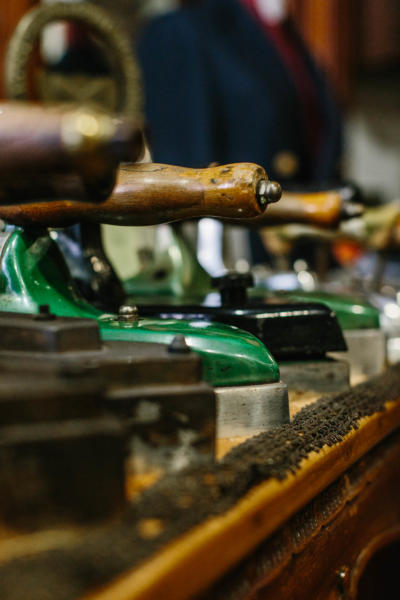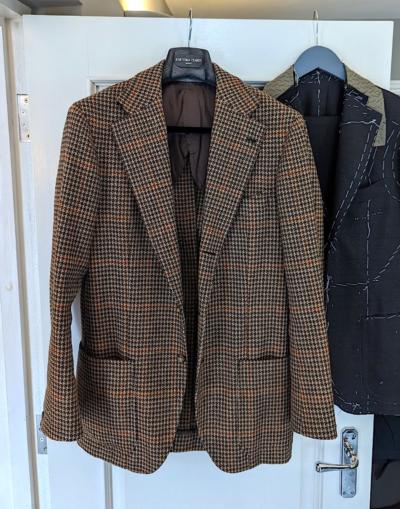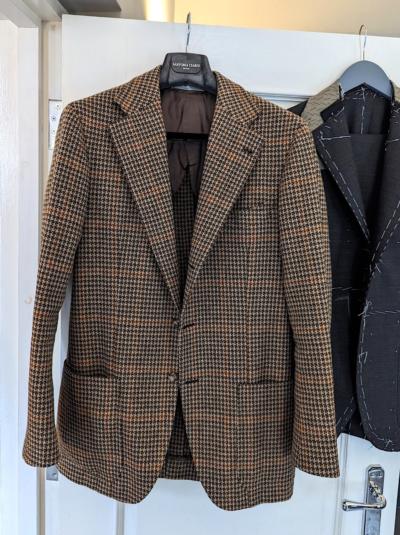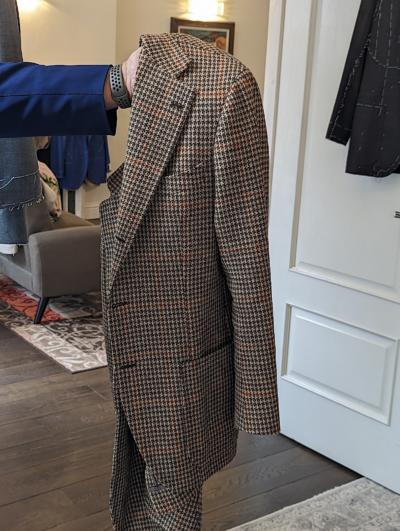How to correct a flattened lapel
Sometimes the lapels of a jacket can get squashed in the wardrobe, making them fold at a point they’re not supposed to (the ‘break point’).
It happens particularly with jackets that have more intentional roll, such as a ‘three-roll-two’, where the jacket has three buttons but breaks a little lower than that, between the third and second button.
This is a style you find more often with southern Italian tailoring - and it’s more likely to go wrong with Italian tailoring too, because the canvas in the lapels and chest is that lighter than an English jacket. French tailoring is more vulnerable to it for the same reason.
You can see the problem in the photo of my Ciardi gun-club check jacket below. Both lapels have been squashed to the point that they’re rolling almost the bottom button. The top button is completely hidden behind the lapel.
Fortunately, fixing this is fairly easy, even if it takes a little bit of confidence and practice for it to feel like an everyday task.
In the video below, I asked Enzo Ciardi to quickly demonstrate.
Now, bear in mind this is in his hotel room in London - so he’s having to use a hotel iron. Normally he would use a heavy tailoring iron and a suction table. Although it is nice to have it demonstrated like this, because it shows how easy it is to do it at home.
The process breaks down as:
- Remove the existing fold that’s been squashed into the jacket:
- Lay the jacket on the ironing board with the lapel folded outwards
- Lay a piece of cotton (eg a tea towel or handkerchief) on top of the lapel
- Press the length of it with the iron, set on moderate steam and heat, but feel free to use plenty of pressure
- Repeat until the fold has disappeared. Often this is enough to return the original roll. But if it's not-
- Put the correct roll back in:
- Fold the lapel over until it’s at the desired break point
- Press the gorge with the iron (the seam where lapel and collar meet)
- Do not press the break itself, as this will create a hard fold rather than a natural roll
- Hold the jacket up, or put it on, to examine the result.
- If necessary, repeat
- Do the same on the other lapel
As is often the case with this kind of maintenance - including polish and cream on shoes - start small and build up. You can always do more but it’s often hard to take away.
Also, keep an eye on the top buttonhole. Often this and the top button are folded halfway back with a normal roll, and it’s when they get flattened that the lapel goes with them. Roll or bend the buttonhole slightly if it helps.
Finally, this is not enough for extreme situations, such as a jacket being squashed at the bottom of a wardrobe. And a full press from a professional will always do a more precise job, or deal with those kinds of situations.
But I’ve done this process at home a few times with different jackets, and it has worked well. My only mistake was not to use enough force or press for long enough, but as I said it’s much better to be too cautious than too extreme.
The result of Enzo’s pressing can be seen above, with the roll now considerably higher up the jacket.
To avoid it happening again, make sure your jackets have enough space between them in the wardrobe. I know it’s always tempting to squash more in, but it’s a short-term gain if some of them then need repressing.
Of course, if your tailor is local then they can also do this for you, and if you’re getting tailoring pressed once or twice a year, it would be part of the process. George at The Valet in London is my go-to presser if a tailor can’t do it.
Any questions before you try it yourself, let me know!
More on how to look after your clothes in the Alterations and Care category of PS. Including:
































Thank you Simon, this is an extremely useful article. Here in Singapore I haven’t managed to find a good dry cleaner yet, and I’m always frustrated when my jackets come back from dry cleaning with a hard fold all the way (not to mention 3-roll-2 jackets converted into 1990’s 3 buttons’ jackets…)
Eek, yes that’s frustrating
Hi Giles, Colony Clothing near Fort Canning is excellent for dry cleaning and alterations. I’ve used them many times and they (Henry) has always done a superb job. Be warned, they are not cheap – but nothing in Singapore is cheap these days!
Thank you John! I will try them. Indeed, nothing is cheap here in Singapore…
Another great ‘How To’ post which I always look forward to, however there may be things I’ll leave to the experts!
I was very much looking forward to a video like this, after a dry cleaner pressed the lapels flat on one of my jackets!!
Thank you!
Oh dear. Let me know if this works well, I haven’t tried it on that kind of issue
I have tried a couple of times to correct it, ironing from the back of the lapel like shown in the video, and then ironing from the other side on top of a folded towel, to have some curvature… It works but after a while they spring back into the flat position.
But I never really used a lot of pressure, so I should try that.
Yes, I’d try a little more heat/steam/pressure/length of time. Also, use something under the iron both when removing and putting it back. And use something thinner than a towel (eg a handkerchief) if a towel is quite thick
Yes, between the iron and the jacket I use a retired cotton shirt, the towel I use below the jacket, so as to simulate an ironing cushion and have something less flat than the board.
Thanks Dario. That towel below might be impeding it a little? You want something flat to press on, and the breathability of the ironing board helps with the steam as well
You mentioned this article would be published and I was waiting for it. A funny coincidence is that I picked up some sports jackets from my tailor just this week, having brought them in to have the lapels repressed. I requested that they lower the roll slightly – it was higher up, breaking above the top button – to optically lengthen the lapels. The repressing also helped to create a neat and ‘fresh’ roll again. Love how these and other maintenance techniques discussed here help to enjoy your clothes year after year.
Nice, pleased to hear it.
Do note, that break point can’t be altered too far, especially on more structured jackets, as some of it is driven by the collar tension and break line in the canvas
As always in tailoring, only small increments, and in any case these were unstructured jackets. Nevertheless, I gladly took the safer option to leave it to experienced hands.
Simon, thank you for this wonderful tutorial. I’ve always appreciated these quick how-to videos from you, for they are practical and accessible by the layman. I know most any cotton would work. But, out of curiosity, what type of cloth do the professionals use as their pressing cloth?
It’s just a piece of waste cotton in my experience, nothing more
Love the practical stuff. Thanks
This is one of the most helpful posts of this type. Extremely useful. Thanks
Haven’t felt the need to comment in a little while. But I love this little article. And it strikes me as exactly the kind of thing that people who love the craft want to know about. It’s practicality in the name of elegance.
And It’s delightful. Thank you.
Lovely to hear, thanks Mike
What’s a good way to deal with the opposite, where the lapel is pressed flat when it shouldn’t be?
You mean pressed higher than it should be rather than lower? Sorry, I would have described this situation as it being pressed flat when it shouldn’t be
Interesting post. Here’s a blog post by a veteran tailor detailing a home suit ironing routine. In it, he specifically cautions that ironing the collar too much can cause it to stretch and lose shape (though he’s not saying never to do it) and that ironing seams with steam (which Enzo doesn’t do) can blow a stitch. I wonder what Enzo thinks about these points and how he’d advise avoiding the issues raised.
I’m going off topic here, even on a tangent, but I’m latching onto two words in your comment, very precious, they are…VETERAN TAILOR.
You may say, what am I driving at?
Simon, even other readers take note here!!
It is this:- Who and where are the veteran tailors now?
We saw and read the excellent but nostalgic articles on the old New York tailors, some sadly no longer with us now. Logsdale still is and doing well.
We will come home to London now.
Royal tailor to the King – Malcolm Plews. Is he still taking on new customers?
Stuart Lamprell is not.
Denman & Goddard is still going at 11 St. George’s Street, the tailor’s den.
Joe Morgan, Edward Sexton,Steven Hitchcock, John Kent, Terry Haste, Brian Lewis & Paul Munday (Meyer & Mortimer), Brian Lishak & Richard Anderson, Kathryn Sargent, Ramroop at Sedwell, my tailor Edwin Deboise,ex Anderson Sheppard and even Jo Mahon at Redmayne. G.Golding ,another Royal Tailor at St.Albans outside London.
Don’t forget the Italians of course.
I don’t necessarily include the regional tailors here.
Have I left any out..please add to….I’m sure the list goes on!!
If you can afford it, please support them and patronise them if you can.
I would love to see more articles on not just the veteran cutters but also,for example, veteran coat makers like the ex Kilgour French & Stanbury now with Hitchcock. Trousermakers, button hole makers, the list could go on.
Thanks Lindsay. Could you not, though, make even a better case for supporting the next generation of tailors, trying to make their own name? Davide Taub, Michael Browne, the team and Whitcomb etc. Some of those older generation of tailors were wonderful, but I wouldn’t say there were consistently better than those younger ones.
Very interesting.
Of course, I totally agree.
My tailor, Steed, has son Matthew and even grandson Chris coming up behind him which is tremendous.
i even found another one,Gordon Alsleben (ex. Huntsman) is on his own and i’m trying to find out a little more about him.
David Ward, ex. Huntsman, Craig Featherstone,ex.Poole, I may well try him!! Oliver Cross,ex. Meyer & Mortimer & Benson & Clegg as you know, Paley Munday, there must be loads more, and the Italians like Sartoria Corcos which i’d love to try one day.
I totally agree with you Simon
many thanks
Lindsay
No problem Lindsay.
Personally, if you don’t mind me saying, I’d hesitate to try so many tailors largely producing the same thing. You will miss out on some of the benefits of bespoke from staying with one tailor over a longer period.
That’s an interesting reply.
To clarify, I certainly don’t wish at this time to try too many tailors producing the same thing as you rightly alluded but I like to try one or two on a different style from my current tailor Steed (drape style) for example:- Kent & Haste or Meyer & Mortimer for a more structured style or my pockets permitting, Dege or Sexton. Even Tom Sweeney, another style again.
In the Italian front:- Sartorial Corcos- it’s the lapels here, very striking and IMO a tad concave, opposite of Steed ..seems a nice guy or Neapolitan tailors with a looser fit for me. Who cuts a looser fitting garment here?
I don’t mean to say that I will be trying all of the tailors that I’ve mentioned here but one or maybe two….keeping my list small but sartorially diverse.
Do I make sense with the above?
Correct me again if necessary.
Many thanks
Lindsay
Hey Lindsay,
You definitely do, and I assumed you probably had that advice in mind already. I just know how exciting it can be trying lots of different people, when if I was starting all over again, I’d concentrate much more on a smaller number. Eg, do you really want to try an expensive and stylised tailor, knowing the second or third commission would like to better in fit and perhaps in the style you pick?
It’s a hard thing and fights against most of the instincts of capitalism, which is why it’s worth restating so often I think.
S
I’ve been dealing with squashed lapels for ages using a small, hand-held clothes steamer. I can take out the fold at the break point to any extent I want, then press down on the top with my hand to establish the top part of the lapel fold, and finally shape the roll on the bottom part of the lapel. I have a lot of two-roll-three sports jackets and suit coats, and I can obtain a desired roll quite easily using the clothes steamer. I rarely have had to use an actual iron.
Thank you. I can certainly see the steamer dealing with removing the lower-down press. It surprises me it works to press with the hand for reintroducing it
What a nice and practical tutorial. I live in Taiwan and it’s so frustrating that no dry cleaner here has a clue on how to iron suits properly. The lapels come back ironed dead flat, always. And interestingly I have just did the first part of ironing about a week ago to fix the flattened lapels and worked quite well. Now I learned how to put the wanted roll back from reading this article today. Btw, I’m using Laurastar from Swiss for the ironing. It’s more on the higher price point for a steam iron, but I think it’s totally worth it, especially for a person who loves tailoring and to wash/maintain them by myself at home. It’s a longterm investment, highly recommended.
Thanks Ryan, and pleased this was helpful
Is it possible to change the point where the lapel folds on a jacket?
I talk about that in replies above to commenters, Nick. Basically, not by very much, not enough to really change the style of the jacket. It’s too set by the tension set in the collar, and the break line between the lapel and the chest canvas
Thanks Simon
“Of course, if your tailor is local then they can also do this for you, and if you’re getting tailoring pressed once or twice a year, it would be part of the process.” Exactly! My tailor also cleans my tailored suits, jackets and overcoats.
You need to build a personal relationship with one tailor whom you know and trust totally . Only then can you maintain your tailoring effectively and protect your substantial financial investment. Having multiple tailors, especially based in other countries, makes it much more more difficult.
Btw, when I was 12, my Dad bought me my first tweed jacket in a very similar Gunclub cloth. It was made by a local tailor whose workroom was next door to his office.
Hi Simon,
Just thought I’d let you know that the link to a random page at the top of the website often takes me to a completely different article. For example, today the article was “Straw hat in the summer” but the link took me to “PS (shorter) shorts are back”.
I was looking for the straw hat article but couldn’t find it.
Please don’t publish this comment. Just for you to know about the issue.
Thanks
Hi CS,
I hope you don’t mind me publishing this comment, just because I wanted to make it clear that when I link to articles in that manner, it’s often because there is an example of what I’m talking about in that post. So with your example, there is no article about straw hats in summer. But the hat I’m talking about is shown in that shorts article.
Thanks
Huh. Makes perfect sense when shown how to do it!
Do you not use Michael N for dry cleaning anymore?
I use both Michael and George at the Valet, largely depending on convenience. I’m near the Valet more, but Michael will pick up from home
Thanks Simon.
Somewhat controversial question: do you find your clothes shrink (a little bit, but enough for the fit to feel a little more snug) after dry cleaning?
I’ve found that no matter who I use (expensive, cheap, highly rated)
Not really to be honest, no. Are we talking knitwear, shirts or tailoring?
Tailoring – suits come back tighter and maybe even a smidge shorter
Really? I haven’t normally found that, no. Maybe try taking them to a professional presser, like the Valet in London or similar.
The Gun Club Check seems to be your favorite blazer
It’s certainly one of them, yes
Hi Simon,
Firstly, I just wanted to say that I really enjoy reading the many articles on your website, even if 99% of the clothes on here are out of my budget! Secondly, I was just wondering if it is possible to roll a lapel on a thick tweed (vintage Magee of Donegal to be exact) sport jacket? I am waiting on delivery of a three button jacket at the moment and would like to make it into a three-roll-two if possible.
Thanks!
Hi JC,
That’s lovely to hear, thank you.
The answer is unfortunately no, not really. Where the lapel rolls to is largely set by the tension in the collar and the position of the canvas inside. The lighter the jacket is, in make, the more possible it is to distort this – but it is really a distortion. You’re losing what the tailor intended in terms of how the collar fits around the neck, for example.
Also obviously more possible on a ready-made jacket where the make hasn’t been that precise, and perhaps on some MTM.
Hey Simon,
I have a handwoven madras jacket and the neck can sit a little off. It’s a very shapable cloth by my estimation. How could I get the cloth to hug my neck better? Shrink the part right behind the neck? Just wondering what you have seen done when they shape a jacket neck with an iron.
I’m not sure anything can be done on a finished jacket just with an iron unfortunately – with the work I’ve seen, it’s done before the collar is set by stitching it all together